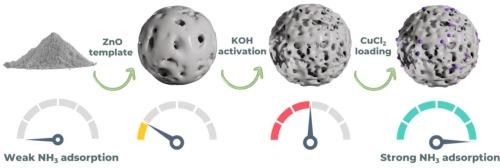Template-activation coupled synthesis of petroleum pitch-based activated carbon for enhanced ammonia adsorption
IF 4.6
3区 材料科学
Q2 MATERIALS SCIENCE, MULTIDISCIPLINARY
引用次数: 0
Abstract
The effective treatment of ammonia in industrial exhaust gases has emerged as a critical environmental challenge worldwide. Activated carbon materials, owing to their substantial specific surface area and tunable surface chemistry, have been widely employed for ammonia adsorption. However, their adsorption capacity is fundamentally constrained by the predominant physical adsorption mechanism. To overcome this limitation, we developed a novel metal chloride-loaded petroleum pitch-based activated carbon adsorbent through an integrated templating and activation approach. The optimized material demonstrated exceptional ammonia adsorption performance, achieving a maximum capacity of 47.81 mg/g with an extended breakthrough time of 106.8 min. Comprehensive characterization through BET surface area analysis, XRD, and SEM revealed that the templating method generated abundant ordered mesopores, while the activation process created a hierarchical pore structure containing both micropores and mesopores. This unique porous architecture facilitated effective metal chloride dispersion and enhanced ammonia diffusion kinetics, resulting in significantly improved adsorption performance.

模板-活化耦合合成石油沥青基增强氨吸附活性炭
工业废气中氨的有效处理已成为世界范围内一项严峻的环境挑战。活性炭材料由于具有较大的比表面积和可调的表面化学性质,被广泛应用于氨吸附。然而,它们的吸附能力从根本上受到主要的物理吸附机制的限制。为了克服这一限制,我们通过集成模板和活化方法开发了一种新型的金属氯化物负载石油沥青基活性炭吸附剂。优化后的材料表现出优异的氨吸附性能,最大吸附量为47.81 mg/g,突破时间延长至106.8 min。通过BET表面积分析、XRD和SEM等综合表征表明,模板法生成了大量有序的介孔,而活化过程生成了包含微孔和介孔的分层孔隙结构。这种独特的多孔结构促进了有效的金属氯化物分散和增强氨扩散动力学,从而显著提高了吸附性能。
本文章由计算机程序翻译,如有差异,请以英文原文为准。
求助全文
约1分钟内获得全文
求助全文
来源期刊

Materials Science and Engineering: B
工程技术-材料科学:综合
CiteScore
5.60
自引率
2.80%
发文量
481
审稿时长
3.5 months
期刊介绍:
The journal provides an international medium for the publication of theoretical and experimental studies and reviews related to the electronic, electrochemical, ionic, magnetic, optical, and biosensing properties of solid state materials in bulk, thin film and particulate forms. Papers dealing with synthesis, processing, characterization, structure, physical properties and computational aspects of nano-crystalline, crystalline, amorphous and glassy forms of ceramics, semiconductors, layered insertion compounds, low-dimensional compounds and systems, fast-ion conductors, polymers and dielectrics are viewed as suitable for publication. Articles focused on nano-structured aspects of these advanced solid-state materials will also be considered suitable.
 求助内容:
求助内容: 应助结果提醒方式:
应助结果提醒方式:


